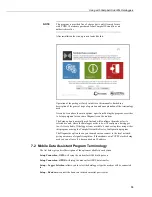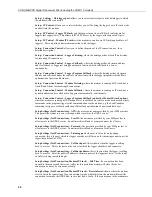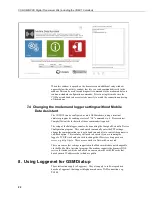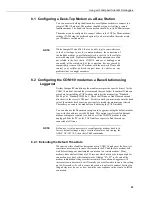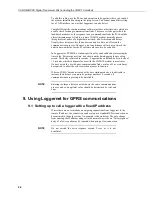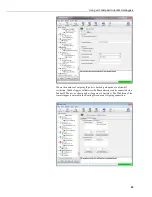
CS-GSM/GPRS Digital Transceiver Kits (including the COM110 modem)
6.4 Selecting and Connecting an Antenna
When selecting an antenna, please note the following points:
•
Make sure the antenna used covers the frequency you intend to use the
COM110 modem on, i.e. does the antenna cover 900 or 1800 MHz, or both
(dual band).
•
Low cost,
¼
- or
½
-wave antennae are adequate for most applications where
signal coverage is good. It is important to realise that most low cost antennae
designed for vehicle mounting require a flat, metal sheet to form a ground
plane at the base of the antenna to achieve the specified gain figure and to
ensure proper impedance matching. As an approximate rule the ground plane
should have a radius equal to or greater than the height of the radiator.
•
Slightly higher priced co-linear, ‘marine’-grade antennae do not require such a
ground plane and can be more easily pole or cross-arm mounted.
•
In areas of poor signal coverage a directional, high-gain ‘Yagi’ antenna can be
considered, but this requires knowledge of where the cell base stations are
situated in order to enable proper alignment.
•
Raising the antenna is often the most effective way of getting better signal
reception. However, if long cables are required to achieve this, use low-loss
extension cables that do not have the significant signal loss of low cost cables.
Long cables are a particular problem when operating at 1800MHz.
•
Like most cellular-based systems, the COM110 modem varies its transmitter
power to ensure good communications with the remote cell station. Using a
cheaper, low-gain, antenna may result in a significant increase in power
consumption in areas of poor signal coverage.
•
If the antenna is placed near the top of a mast or has long antenna cables it may
be vulnerable to lightning damage. If lightning is common at the installation
site, additional lightning protection may be required to protect the COM110
modem – please contact Campbell Scientific for further advice.
Using an antenna that is installed incorrectly, or with faulty wiring,
can lead to premature failure of the transmitter output of the
COM110.
Install the antenna so that the radiator is positioned away from other vertical metal
structures. It should also be at a distance from any sensors so that it does not either
physically or electrically interfere with the sensor readings. If the COM110
modem is connected to a PC (see below) it is possible to check the received signal
strength using the
AT+CSQ
command (see Appendix C for further details). This
can be used to find the optimum antenna position. You should aim to get the
highest signal strength (as close to 31) as possible. For reasonable
communications you need a minimum level of approximately 10 when operating
in non-transparent mode for dial-up or 12-14 for GPRS use. Be sure that the
modem is configured to talk only to the network operator you intend to use when
doing this (see the
AT+COPS
command).
Many antenna have bodies that are connected to the coaxial
cable screen. It is therefore essential to ensure the correct
polarity is maintained through the cabling system to avoid the
possibility of shorting the transmitter output of the COM110
modem to the power supply ground via the lightning
protection cables and mounting structure.
CAUTION
CAUTION
16


















